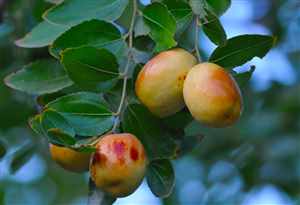Jujube (Ziziphus zizyphus)
Main Facts about Jujube

Using Jujube
It aids weight gain, improves muscular strength and increases energy and stamina. In Chinese medicine it is prescribed as a tonic to strengthen liver function. Japanese research has shown that jujube increases immune system resistance. The fruit is very soothing to the throat and decoctions of jujube have been used to treat sore throats. The dried fruits are used internally in the treatment of chronic fatigue, loss of appetite, diarrhea, pharyngitis, bronchitis, anaemia, and irritability. The seed is used internally in the treatment of palpitations, insomnia, nervous exhaustion, night sweats and excessive perspiration. The root is used in the treatment of dyspepsia. A decoction of the root has been used in the treatment of fevers. The root is made into a powder and applied to old wounds and ulcers. The leaves are said to promote the growth of hair. They are used to form a plaster in the treatment of strangury. The plant is a folk remedy for anaemia, hypertonia, nephritis and nervous diseases. The plant is widely used in China as a treatment for burnsJujube is a remedy for: Cold and flu, Anxiety
Caution!
Caution in diabetics on allopathic medicationCooking with Jujube
Fruit is eaten as a snack. The chinese love these and use them in everything. The fruit can be eaten fresh, dried, cooked in puddings, cakes, breads, jellies, soups, or added to drinks. The dried fruit has the nicest taste. The fruits are often left to become wrinkled and spongy, which increases their sweetness, and are then eaten fresh or cooked. The dried fruit can also be ground into a powder. This powder is used in the preparation of 'kochujang', a fermented hot pepper-soybean paste that resembles miso. The fruit can be used as a coffee substitute. Leaves - cooked. A famine food, they are only used when all else fails.How to grow Jujube
A no-care plant that grows on dry gravelly or stony slopes of hills and mountains. It cannot grow in the shade. It prefers dry or moist soil and can tolerate drought, though it requires hot summers and sufficient water for acceptable fruiting.| Jiaogulan |
Juniper
|